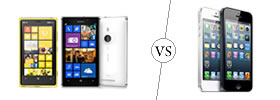Difference between Samsung Galaxy S5 and HTC One M8
Key Difference: HTC launched the HTC One M8, following which Samsung launched its Samsung Galaxy S5. The chassis of the M8 is of a sleek aluminum build, while Samsung has stuck with its polycarbonate that some have criticized feels like plastic. On the inside, both phones are powered by Qualcomm Snapdragon 801, Krait 400 CPU, Adreno 330 GPU and 2 GB RAM.
 The smartphone industry is a very competitive one. There are many OEMs who constantly release new phones in order to capture an increased market share. Samsung and HTC are two such OEMs. Samsung currently leads the industry with the largest market share; however its market share is constantly under attack from other OEMs such as HTC. Samsung and HTC recently launched their latest flagship phones. HTC launched the HTC One M8, following which Samsung launched its Samsung Galaxy S5.
The smartphone industry is a very competitive one. There are many OEMs who constantly release new phones in order to capture an increased market share. Samsung and HTC are two such OEMs. Samsung currently leads the industry with the largest market share; however its market share is constantly under attack from other OEMs such as HTC. Samsung and HTC recently launched their latest flagship phones. HTC launched the HTC One M8, following which Samsung launched its Samsung Galaxy S5.
The M8 features a 5 inch Super LCD3 capacitive touchscreen, whereas the S5 features a 5.1 inch Super AMOLED capacitive touchscreen. Even though the S5 has a larger screen, the M8 is the one that is slightly larger and thicker in size. The displays on both have a Full HD resolution; however the HTC has a better pixel density, (441 ppi vs 432 ppi on the S5) as it has a slightly smaller display. However, the difference will not be visible to the naked eye.
The chassis of the M8 is of a sleek aluminum build, while Samsung has stuck with its polycarbonate that some have criticized feels like plastic. On the inside, both phones are powered by Qualcomm Snapdragon 801, Krait 400 CPU, Adreno 330 GPU and 2 GB RAM. The S5 clocks a top speed of 2.5 GHz, whereas depending on the market variant, the M8 can clock in at either 2.3 GHz or 2.5 GHz.
The M8 introduces a 4-megapixel "Ultrapixel." The phone features a dual-camera technology which allows the phone one camera to focus on the foreground and the other to focus on the background. The user can then pick which one to bring into focus on the picture. The S5, on the other hand, includes a 16 MP ISOCELL camera and uses a hybrid autofocus system that uses standard auto focus with phase detection autofocus, which means that the camera auto focuses in upto 0.3 seconds, which is faster than most phone cameras. Both phones have a 1080p front facing camera, the S5 a 2 MP, while the Z2 a 2.2 MP.

Additionally, while the S5 has the traditional rear-mounted speaker, which is quite good in quality. The M8 changes this up, by featuring front speakers placed above the screen. These speakers which HTC calls the "BoomSound" setup provides sound with a better clarity, bass and volume.
Each of the two phones boasts some extra features to make them more desirable. The S5 is dust and water resistant. It has an IP67 rating which means that it can be submerged in water up to 3.3 feet for up to 30 minutes without suffering damage. The M8 has an IPX3 rating, which means that it is protected from water sprays but that’s it.
The S5 also features a fingerprint scanner it in its home button. It also has a heart rate monitor on the back that syncs with an updated S Health App. The S5 is also upgraded to USB 3.0 which means that it allows for faster data transfer rates and reduced charging times. It also features a new Ultra Power Saving Mode, which when activated turns the phone into black and white and shuts down all background apps, allowing the battery to last longer. The M8 features Motion Launch, which allows one to unlock the phone without reaching for the power button.
Comparison between Samsung Galaxy S5 and HTC One M8:
|
|
Samsung Galaxy S5 |
HTC One M8 |
|
Launch Date |
April 2014 |
March 2014 |
|
Company |
Samsung Electronics |
HTC Corporation |
|
Size |
142 (5.59in) x 72.5 (2.85in) x 8.1 mm (0.32 in) |
146.4 (5.76 in) x 70.6 (2.78 in) x 9.4 mm (0.37 in) |
|
Display |
5.1 inches (diagonal) Super AMOLED capacitive touchscreen |
5.0 inches (diagonal) Super LCD3 capacitive touchscreen |
|
Screen |
1080 x 1920 pixels, 16M colors (~432 ppi pixel density) |
1080 x 1920 pixels, 16M colors (~441 ppi pixel density) |
|
Protection |
Corning Gorilla Glass 3 |
Corning Gorilla Glass 3 |
|
Weight |
145 g (5.11 oz) |
160 g (5.64 oz) |
|
2G Network |
GSM 850 / 900 / 1800 / 1900 - all versions |
GSM 850 / 900 / 1800 / 1900 |
|
3G Network |
HSDPA 850 / 900 / 1900 / 2100 - SM-G900F HSDPA 850 / 1900 / 2100 - SM-G900A HSDPA 850 / 900 / 1700 / 1900 / 2100 - SM-G900M HSDPA 850 / 1700 / 1900 / 2100 - SM-G900T |
HSDPA 850 / 900 / 1900 / 2100 - EMEA, Asia HSDPA 850 / 1900 / 2100 - AT&T HSDPA 850 / 1700 / 1900 / 2100 - T-Mobile |
|
4G Network |
LTE 800 / 850 / 900 / 1800 / 1900 / 2100 / 2600 - SM-G900F LTE 700 / 850 / 1700 / 1800 / 1900 / 2100 / 2600 - SM-G900A LTE 700 / 850 / 1700 / 1900 / 2100 / 2600 - SM-G900M LTE 700 / 850 / 900 / 1700 / 1800 / 1900 / 2100 / 2600 - SM-G900T |
LTE 800 / 900 / 1800 / 2600 – EMEA LTE 700 / 900 / 1800 / 2100 / 2600 – Asia LTE 700 / 1700 / 2100 - T-Mobile LTE 700 / 850 / 1700 / 1800 / 1900 / 2100 / 2600 - AT&T LTE 2300 - India |
|
GUI |
TouchWiz UI |
HTC Sense UI 6.0 |
|
CPU speed |
Quad-core 2.5 GHz Krait 400 |
Quad-core 2.3 GHz (US/EMEA)/ 2.5 GHz (Asia, China) Krait 400 |
|
GPU |
Adreno 330 |
Adreno 330 |
|
OS |
Android OS, v4.4.2 (KitKat) |
Android OS, v4.4.2 (KitKat), upgradable to v4.4.3 (KitKat), planned upgrade to v5.0 (Lollipop) |
|
Chipset |
Qualcomm MSM8974AC Snapdragon 801 |
Qualcomm MSM8974AB Snapdragon 801 |
|
RAM |
2 GB RAM |
2 GB RAM |
|
SIM Size |
Micro-SIM |
Nano-SIM |
|
Internal Memory |
16/32 GB |
16/32 GB |
|
Expandable Memory |
microSD, up to 128 GB |
microSD, up to 128 GB |
|
Sensors |
Gesture Sensor, Fingerprint Sensor, HR Sensor, Hall Sensor, Accelerometer, Geomagnetic Sensor, Gyro Sensor, Light Sensor, Barometer, Proximity Sensor |
Accelerometer, Proximity sensor, Ambient light sensor, Gyro sensor, Barometer sensor |
|
Connectivity |
GPRS, EDGE, Wi-Fi 802.11 a/b/g/n/ac, dual-band, Wi-Fi Direct, DLNA, Wi-Fi hotspot, Bluetooth 4.0, USB v3.0 |
3.5 mm stereo audio jack NFC Bluetooth 4.0 with aptX enabled Wi-Fi: IEEE 802.11 a/b/g/n/ac (2.4 & 5 GHz) DLNA for wirelessly streaming media from the phone to a compatible TV or computer HTC Connect micro-USB 2.0 (5-pin) port with mobile high-definition video link (MHL) for USB or HDMI connection (Special cable required for HDMI connection.) Support consumer infrared remote control |
|
Data |
GPRS, EDGE, WLAN, Bluetooth, USB, NFC |
GPRS, EDGE, WLAN, Bluetooth, USB, NFC |
|
Speed |
HSDPA, 42.2 Mbps; HSUPA, 5.76 Mbps; LTE, Cat4, 50 Mbps UL, 150 Mbps DL |
HSPA 42.2/21.1(AT&T)/5.76 Mbps, LTE Cat4 150/50 Mbps |
|
WLAN |
Wi-Fi 802.11 a/b/g/n/ac, dual-band, Wi-Fi Direct, DLNA, Wi-Fi hotspot |
Wi-Fi 802.11 a/b/g/n/ac, dual-band, Wi-Fi Direct, DLNA, Wi-Fi hotspot |
|
Bluetooth |
v4.0, A2DP, EDR, LE |
v4.0, A2DP |
|
USB |
microUSB v3.0 (MHL 2.1), USB On-the-go, USB Host |
microUSB v2.0 (MHL), USB On-the-go, USB Host |
|
Primary Camera |
16 MP, 5312 x 2988 pixels, phase detection autofocus, LED flash |
HTC Ultrapixel Camera + Duo Camera (4MP), 2688х1520 pixels, autofocus, dual-LED (dual tone) flash, |
|
Secondary Camera |
2 MP, 1080p@30fps, dual video call |
5 MP, 1080p@30fps, HDR |
|
Video |
2160p@30fps, 1080p@60fps, 720p@120fps, HDR, dual-video rec Video Playing Resolution: UHD 4K (3840 x 2160), @30fps |
1080p@60fps, 720p@120fps, HDR, stereo sound rec. |
|
Camera Features |
|
|
|
Sound Enhancement |
Active noise cancellation with dedicated mic |
Active noise cancellation with dedicated mic HTC BoomSound Dual frontal stereo speakers with built-in amplifiers Sense Voice |
|
Audio supported formats |
3GA, AWB, FALC, MID, MXMF, OGA, OTA, RTX, RTTTL, XMF, AAC, AMR, IMY, M4A, MIDI, MP3, OGG, WAV, WMA |
.aac, .amr, .ogg, .m4a, .mid, .mp3, .wav, .wma (Windows Media Audio 10) |
|
Video supported formats |
FLV, M4V, MKV, MP4, WEBM, WMV, 3G2, 3GP, ASF, AVI |
3gp, .3g2, .mp4, .wmv (Windows Media Video 10), .avi (MP4 ASP and MP3) |
|
Battery Capacity |
Li-Ion 2800 mAh battery |
Embedded rechargeable Li-polymer 2600 mAh battery |
|
Stand-by |
Up to 390 hours |
Up to 496 hours for 3G |
|
Talk time |
Up to 21 hours |
Up to 20 hours for 3G |
|
Available Colors |
Charcoal Black, Copper Gold, Electric Blue, Shimmery White |
Gunmetal Gray, Glacial Silver, Amber Gold |
|
Messaging |
SMS(threaded view), MMS, Email, Push Mail, IM |
SMS (threaded view), MMS, Email, Push Email |
|
Browser |
HTML5 |
HTML5 |
|
Radio |
No |
Stereo FM radio with RDS |
|
GPS |
Yes, with A-GPS, GLONASS, Beidou |
Yes, with A-GPS, GLONASS |
|
Java |
Yes, via Java MIDP emulator |
Yes, via Java MIDP emulator |
|
Additional Features |
|
|
Image Courtesy: gadgetblur.com, htc.com









Add new comment